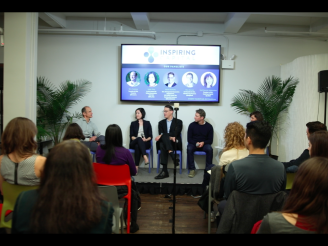Circular Economy
—

The circular economy is a broad topic, but represents an approach to business aimed at turning our traditional linear economic model of take → make → waste, into a closed system in which waste (in all its forms) becomes a resource. The pace at which circular principles and business models are being implemented is rapidly accelerating, as is evidenced by the release of the CEO Guide by the World Business Council for Sustainable Development, the number of companies being recognized as part of the annual Circular Economy Awards program, the number of companies and collaborating with the Ellen MacArthur Foundation, and companies making the circular economy central to its corporate strategy (see the recent announcement by VF Corp.). Despite its growth and buzz, questions still abound about what the circular economy is and how organizations can profit by implementing its principles.
I joined a number of circular economy leaders to discuss some of those questions at a recent panel hosted by Inspiring Capital at Civic Hall. Moderated by Nell Derick Debevoise (Founder and CEO of Inspiring Capital), I and the other panelists including Ron Gonen (CEO and Co-founder of the Closed Loop Fund), Eric Hudson (CEO of Preserve) and Kate Daly (Senior Vice President at the Center for Urban Innovation, in New York City’s Economic Development Corporation) discussed a wide range of circular economy topics, among them:
The event was live streamed and the video is available for view at:
https://www.facebook.com/CivicHallNYC/videos/1971214379571751/?hc_location=ufi
Additional resources:
Kevin Eckerle
Director of Corporate Research and Engagement
NYU Stern Center for Sustainable Business
I joined a number of circular economy leaders to discuss some of those questions at a recent panel hosted by Inspiring Capital at Civic Hall. Moderated by Nell Derick Debevoise (Founder and CEO of Inspiring Capital), I and the other panelists including Ron Gonen (CEO and Co-founder of the Closed Loop Fund), Eric Hudson (CEO of Preserve) and Kate Daly (Senior Vice President at the Center for Urban Innovation, in New York City’s Economic Development Corporation) discussed a wide range of circular economy topics, among them:
- The business case for circularity: The consensus of the panel was that the biggest benefits are reducing procurement costs and mitigating risk. Cost reductions can be achieved by turning waste outputs into resource inputs, thereby reducing the need to purchase virgin raw materials are higher prices. Similarly, as resources become scarcer and commodity prices more volatile, avoiding purchases of virgin materials represents a cost-effective hedge against price spikes and more expensive virgin materials.
- The biggest barriers to implementing circular solutions: Among the biggest challenges are siloed thinking and lack of communication. Ron Gonen provided the example that black plastics cannot be recycled at most recycling facilities, not because of any issue with the plastic, but because the black color of the object blends in with the conveyor belt, rendering the object unidentifiable. Were product designers talking with the development teams at the outset, and each were considering how the product will be handled at its end of life, these issues could be avoided.
- The biggest enablers for accelerating circular implementation: Rapidly evolving and improving technology. This includes digital technology, which is enabling better and more transparent corporate-to- consumer communication, as well as consumer-to- consumer communication, and supporting, among other things, the numerous sharing platforms like Airbnb. It also includes the rapidly evolving technology that enables better and more cost-effective recycling.
The event was live streamed and the video is available for view at:
https://www.facebook.com/CivicHallNYC/videos/1971214379571751/?hc_location=ufi
Additional resources:
- Circular Advantage: Innovative Business Models and Technologies that Create Value
- Full Circle: Turning Waste into Value in your Supply Chain
- A New Textiles Economy: Redesigning Fashion’s Future
Kevin Eckerle
Director of Corporate Research and Engagement
NYU Stern Center for Sustainable Business
Posted in
center for sustainable business
,
circular economy
